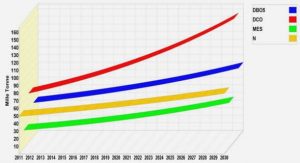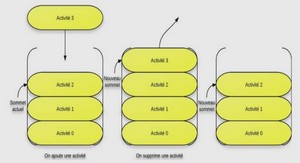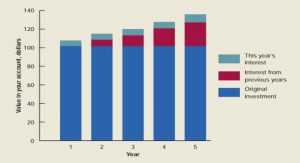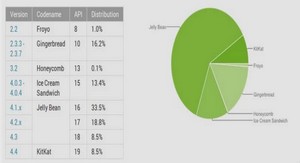Conséquences à long terme de l’exposition in utero à des médicaments
Pharmacoepidemiology for real-life evaluation: an increasing number of large databases
Post-marketing assessment of risks and benefits of medication use during pregnancy is therefore essential. Many sources (described above) have been available for a long time. Nevertheless, some of their limitations (selection bias, small sample size, retrospective data collection) remain obstacles to a fair assessment of medication risks during pregnancy. Hence, electronic databases have been increasingly used in recent years. Databases, augmented on purpose, combine different healthcare sources, for drug assessment in pregnancy [35]. Moreover, some of them have extended the period of follow up of the prenatally exposed infant in order to capture delayed effects such as developmental disorders (for example the cohort POMME, see above). Fetal development is a critical period for shaping the lifelong health of an individual. The ‘fetal programming’ hypothesis proposes that alterations during fetal development result in adaptations that permanently change structure, physiology and metabolism which can lead to adverse long-term health consequences. For example, glucocorticoids drive changes in gene regulation that are necessary for normal growth and maturation. The fetal hypothalamic-pituitary-adrenal axis is particularly susceptible to long-term programming by glucocorticoids; these effects can persist throughout the life of an organism. Moisiadis VG et al. showed that dysfunction of the hypothalamic-pituitaryadrenal axis as a result of fetal programming is associated with impaired brain growth, altered behavior and increased susceptibility to chronic disease (such as metabolic and cardiovascular disease) [46,47]. Thus, the increase in both the number of registered variables and the duration of the follow up expands the probability to detect a low signal. Although pharmacoepidemiologic studies have limitations, they provide the advantage that they use real-life data. Unlike clinical trials, patients captured by databases are rather representative of the general population (multiple illnesses, polypharmacy). Another potential strength of pharmacoepidemiologic studies is their ability to detect rare effects provided that they are conducted using sources with adequate sample size. For example, to detect a doubled risk of malformation after prenatal exposure to drugs, the minimum number of exposed subjects who need to be enrolled in the study is higher than 1000. To detect an increase in the risk of a specific malformation which prevalence in the general population is 0.1% (such as oral cleft), 20 times more patients are required: in a database of 100 000 pregnant women, at least one out of five must have taken the medication. A review of European health care databases in 2014 showed that the number of pregnancies in these databases ranges from 27 000 to 130 000 according to the country [48]. Thus, when focusing on a specific congenital abnormality and infrequently used medications, the study should be conducted using a so large-sized sample that a single database might be not sufficient. To that end, consortiums have been developed in recent years enabling multicentric studies. For example, EUROmediCAT is a European research consortium dedicated to improving medication safety in pregnancy [49]. It started work on 1 March 2011 with financial support provided by the European Union and was established as a daughter project to EUROCAT (European Surveillance of Congenital Anomalies. Since then, EUROmediCAT has diversified its funding sources, as can be seen under EUROmediSAFE, which is an Independent Research Consortium comprising of 11 partner institutions from Belgium, France, Germany, Italy, the Netherlands and the UK. It focuses on studies involving medication use during pregnancy [50].
Beyond the boundaries thanks to different ways of analyzing data
Nonclassical drug utilization studies offer an alternative to estimate in utero drug exposure. For example, a recent study has used the Trajectory Method to identify profiles of exposure (in terms of intensity and evolution during pregnancy) and evaluate the effects of in utero exposure to anxiolytics and hypnotics on the adaptation to extra uterine life [52,53]. Pregnant women were classified according to their profile exposure, which was determined in three steps: (a) Conversion of prescription data into exposure variables (using ATC-DDD), (b) Construction of individual trajectories of exposure, and (c) Clustering of individual trajectories of exposure. A significant difference in ‘neonatal pathologies’ rates depending on the exposure profiles was found. High anxiolytic– hypnotic burden throughout pregnancy may affect newborn health. Conversely, a low constant level of exposure to these drugs during pregnancy or a decrease during the first trimester of pregnancy to low level of exposure does not appear to affect newborn health. However, it cannot be excluded that the different profile exposure might indicate maternal conditions that increase risk of neonatal pathologies. This bias has been limited by adjusting on maternal factors such as the number of drugs that have been taken during pregnancy. Epidemiological studies are often criticized because of the existence of confounding factors that may limit the results interpretation. Indeed, it is important to separate an effect caused by the medication from the underlying risk associated with environmental and genetic factors. One of the solutions to consider potential confounders is to implement a propensity score, which is the conditional probability of receiving a medication given a vector of measured and unmeasured covariates. On the one hand, exposed and unexposed subjects can be matched on the propensity score. This ensure of the comparability of subjects. On the other hand, propensity score can be used as adjustment variable in statistical models when assessing causal effects. For example, antipsychotic drug use in pregnancy was evaluated through a high dimensional propensity score matched cohort study [54]. Some different designs, such as the case-time-control, can also be used to evaluate the effect of intermittent exposures on the risk of acute events. The design uses subjects as their own controls. Self-matching of cases eliminates the threat of control-selection bias and increases efficiency. Hernández-Díaz S et al. realized a study to assess the advantages of using casecrossover and case-time-control designs in birth defects research. They compared these two innovative approaches with a traditional case-control study design that evaluated the association between use of folic acid antagonists during the second and third pregnancy months and the risk of cardiovascular defects. Their results suggested that innovative designs would be advantageous over the case–control design only in certain limited setting [55]. Another possible solution to avoid bias is to perform ‘sibling’ controlled studies. This design provides an effective approach to control for maternal factors, since siblings grow in the same family environment and have in common half of their DNA. Only discordant siblings are informative because they may only differ on prenatal drug exposure. Such studies need to be performed on a large epidemiological cohort to ensure enough discordant pairs. For example, Brandlistuen et al. conducted a sibling controlled study in the populationbased Norwegian Mother and Child Cohort Study in order to evaluate the association between prenatal antidepressant exposure and behavioral problems [56].
RESUME |





